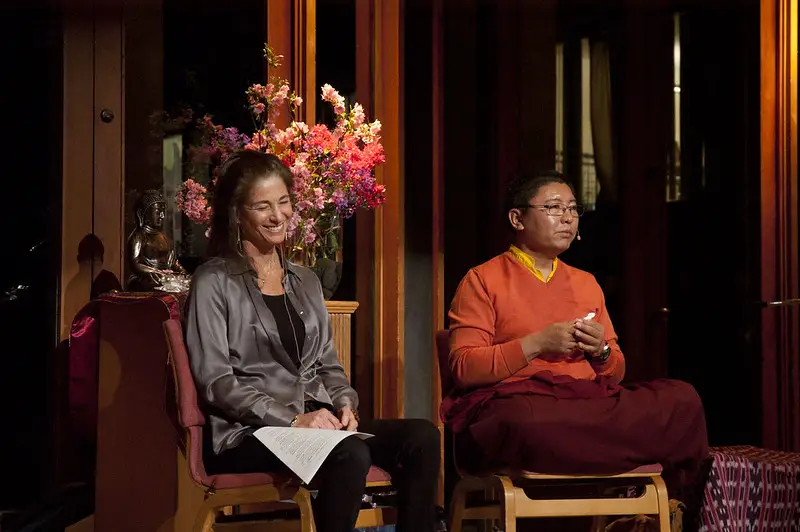The universe can be a stormy, disturbing place. Our media is usually a continuous stream of sad news, also, our personal lives can be likewise troubled with doubt, worry, and stress. In these book chapters, you’ll discover how to handle these difficulties by making use of RAIN, the philosophy and practice of mindfulness expert and clinically skilled psychologist, Tara Brach.
A mixture of eastern spiritual practices as well as contemporary brain science, RAIN meditation practice is a way to peace in four steps: Recognize, Allow, Investigate, and Nurture.
In these book chapters, you’ll discover the abilities as well as mindset needed to enhance your own RAIN meditation practice. Loaded with practical hints as well as interactive narratives from an era of helping others to live in the present, the direction of Brach will assist you to gain the benefits of a more mindful life.

Chapter 1 – You can form the mental space you require to get that viewpoint, by making use of the RAIN meditation method.
With tasks, bills, traffic, as well as meetings; at times, day to day daily life can look like an infinite display of things to do and issues to fix. Surviving the day can seem like being lost in a thick forest: all over each corner is just more undergrowth, with no sign of an exit.
In these instances, when you feel as though there is no exit, make a clearing. Make a small space to breathe. You’ll see that after you do that, you’ll eventually be able to find a way forward. It seems very easy enough; however, how do you do that?
Therefore, what is the RAIN method? RAIN is an abbreviation for four-step meditation practice. It’s made to offer you space from life’s issues, and let you live in the present. During the late 1980s, that was when the first three steps were created by Michele McDonald, the senior Buddhist teacher. Since that time, Tara Brach has enhanced and mastered the practice, including the last step to awaken self-compassion.
When you feel like you are overwhelmed, worried or nervous– what Brach refers to as “being in a trance” – practicing RAIN can assist you to let go of those negative feelings and be present in the moment.
The RAIN meditation practice starts with R, which represents Recognize. The reason is that, with this one, you need to first recognize you’re in a trance. You can do this by detecting red flags like compulsive actions, pondering on anxious thoughts, or rushing to finish things.
A which stands for Allow is the following step. With this, don’t attempt to alter anything just yet. Just take a breath, and let yourself feel what is going on without judgment.

As soon as you are focused, it’s now time for the following step which is I, or Investigate. This asks you to focus your concentration inward to reveal the reason you are experiencing those feelings and what you may require to get better. Are you experiencing fear of failure? Are you feeling undecided by various priorities? What kind of assurance would assist you to move forward?
The last step is N which stands for Nurture. End your meditation by conveying a message of support inward to yourself. Kindly relax your body as you ponder on positive phrases such as, “You will be okay,” or “We can do this.”
Doing these four steps may just need a few minutes; however, it can produce strong outcomes. RAIN meditation assists you to move your focus away from the outside realm and toward your inner self. In the following chapter, we’ll take a closer look at the first two steps.
Chapter 2 – When you go through negative feelings, don’t lash out in rage. React with kindness.
Over 2000 years ago, the Buddha traversed northern India passing a message of kindness and freedom. Although, he didn’t travel alone. The god of hatred and greed known as Mara went with him the length of his journeys.
However, fascinatingly, any time Mara arrived, the Buddha didn’t fight him off. Rather, he would meet the demon and quietly utter that, “Mara, I can see you. Come, let’s drink tea.” By doing that, the Buddha showed the first two steps of RAIN: Recognizing and Allowing.
Mara comes in our own lives in the form of painful experiences such as fear, jealousy, and failure. When these emotions appear, we’ve learned to tackle them by saying “no.” We attempt to combat them, we blame them, or we surrender.

RAIN teaches us to do the opposite. With RAIN, we learn to embrace these negative emotions without judgment, letting us react to them consciously instead of just reacting.
Consider the story of Roger, a strong executive at a technology firm. The pressure of his work made him be short-tempered, mean, and wicked to the people he loved. Brach asked to assist him with the first two steps of RAIN meditation.
Initially, she told Roger to shut his eyes and concentrate on an occurrence that had initiated his temper. Then, she told Roger to Recognize how he felt in the instant of anger. He felt nervous, heated, ready to flare off. After she told him to Allow himself to feel these feelings –instead of responding instantly, he had to sit with his anger and just let it be.
As he used an instant to feel the anger, Roger felt it going. These two steps may look little; however, when you Recognize and Allow negative emotions, you create space to react with compassion rather than anger.
It is significant to make this process a routine. A lot of research studies reveal that practicing mindfulness consciously is a learned ability and it can be enhanced with time. You may not usually get it precisely correct; however, with consistent attempts, your brain will get used to it. Recognizing and Allowing will turn into a normal aspect of your thought patterns.
The same applies to the following two steps, Investigating and Nurturing.
Chapter 3 – We have to break down our defensive barriers in order to discover our inner love and kindness.
During the 1950s, an order of monks needed to move their huge, cherished statue of the Buddha. During that process, it got destroyed, also the outer surface of clay cracked and broke. What the monks witnessed surprised them: the cracks showed that beneath, the Buddha statue was made of solid gold.
The monks assume that the outer shell of clay was included hundreds of years before, to safeguard the precious Buddha during a time of war. Also, they assume that there is a lesson to be learned from this.
Just like the statue, we as well form hard outer shells to defend us during times of disaster. Also, similar to the golden statue, these hard defense mechanisms can at times hide our most treasured characters.
The second two steps in the RAIN meditation practice can assist us with this process. These steps are Investigating and Nurturing. In order to reveal how this functions, Brach narrates the story of one of her student’s daughters, Sophia.

Sophia went through a really hard breakup as a junior in college. She was heartbroken and depressed; hence, she took a break from school. She was in such misery, she couldn’t go back to school. In order to help her overcome this struggle, Brach guided her in RAIN meditation.
After Recognizing and Accepting her feelings first, Sophia had to Investigate the reason why she felt really lost and unhappy. She directed her concentration inward and got to know that deep down, she felt like a little kid, scared of being left alone. Her self-examination revealed the cause of her deep unhappiness.
In order to assure this aspect of herself, Sophia needed to Nurture that inner child. She Nurtured it by putting her hand on her heart and saying soothing words to herself. Words such as “I am here for you,” and “I care.” As she uttered these words, Sophia mended the psychic wounds of the breakup and was ultimately able to go back to school.
A different method you can practice Nurturing, and find your own concealed gold, is to call on your future self. Relax, before starting on this path. Visualize yourself 20 years in the future. Reveal your present issues with this future and get their help as well as care. You’ll see that they may provide you the assistance you require.
Since you are more conversant with RAIN meditation, it’s now time to think about how to use it in some of life’s most frequent issues.
Chapter 4 – For you to improve, we have to let go of negative thoughts about ourselves.
Unlovable, a failure, lazy. Harsh phrases such as these are painful and disheartening. Unluckily, a lot of people hear these criticisms every time– and they don’t hear it from some bully or outside antagonizer. They hear this judgment from themselves.
All of us have some kind of negative feelings about ourselves. Even worse, they can be really difficult to disregard or let go of. The reason is that our brains are very much better at recalling painful incidences, such as the times we’ve not successfully done something or when we’ve been hurt. In the past Millions of years, this prejudice was a beneficial survival nature. Currently, it makes us remember the worst events of our lives while disregarding the good experiences.
When we continuously ponder on our perceived blemishes, they turn out to be part of our identity. The negative things we say to ourselves about being useless or unworthy, eventually, refrain us from attaining happiness and relating with other people
Practicing RAIN can assist you to shed these mental blocks.
When you’re pondering on a former error or saying to yourself, “Something isn’t right with me,” think of the first step in RAIN. Which is to recognize that you’re engaging in negative thinking. After that, allow yourself to experience the negative feelings related to that thought. Take note of the feelings it gives to your body.
After that, investigate the belief. Question yourself, “Is this actually real?” Often time, you’ll realize that your worst feelings don’t map onto reality. Take time to ask questions about the fact of that negative self-belief. You’re more likely to discover that they’re exaggerations, misrepresentations, or total lies.

As soon as you understand this truth, ask the question: “What will occur if I let go of this belief?” Letting go of a long-held belief about yourself, even if it is a negative belief, can be frightening. It can be as if your skin is peeling and leave you feeling unprotected or vulnerable. However, it also forms space for development.
Mark Nepo, the poet refers to this step of letting yourself to grow “the exquisite risk.” This is a risk since we leave the familiar; however, it is exquisite since we let inner beauty, sensitivity, as well as kindness to be discovered.
Chapter 5 – It’s truly significant that we cultivate our inner goodness in order to defeat shame.
This is a well- known story: a rich father that has two sons. The younger son requests for his inheritance early. He leaves the house and goes on to use his entire inheritance on a lavish lifestyle. A few years after, he becomes broke without any money, the son has to go back home with nothing except his shame.
Although, the father doesn’t reject him. Rather, he celebrates. He welcomes his son back with open arms and forgiveness.
Sometimes, all of us have been this prodigal son; someone ashamed of our feelings and deeds. However, RAIN meditation practice instructs us that we have to also be the father – we need to learn to meet our own shame with compassion and love.
What is the definition of shame? Shame is a feeling that occurs when we assume that our flaws are really huge that other people will not accept us anymore into their society. This deep-rooted dread of being expelled can be really stressful and disastrous which can bring about self-hate.
A powerful remedy to the power of shame is fostering radical compassion for ourselves, and this can be done via Nurturing – the last stag in the RAIN meditative practice.
Brach shows this with the illustration of a different student named Sean. During the financial crisis of 2008, Sean lost his work. After sixteen failed months of searching for a job, he was still jobless. Without having any job, Sean felt as if he was failing his family. He felt as if he was a burden to them. He felt shame.

In order to defeat this painful feeling, Brach made Sean practice Nurturing. She told him to ponder on the support group he went to for other men in his condition. He focused on the respect they had for one another, and the society they’d created. By concentrating on those positive emotions, Sean was capable to cultivate his inner self-worth and discover the power to forgive himself.
At times, for you to nurture your inner goodness, you might discover that you need to search for compassion outside yourself. Talk to the people you love, communicate with nature, or imagine the existence of an esteemed spiritual leader such as the Dalai Lama or Kwan Yin, the bodhisattva of compassion. Feel the warmth of their love.
Anywhere you see compassion; it’s significant to be open to its healing ability. When you are practicing RAIN, use a few minutes all the time to feel the love of other people and tell yourself that no mistake is really huge to defeat.
Chapter 6 – In order to have power over feelings such as anxiety and fear, we have to face them directly.
One time, a child experienced chronic nightmares. Each night, he dreamed that he was being pursued through the woods by a huge invisible monster. But, during one night, having gotten enough of these nightmares, he decided to confront his fear. He stooped and turned to have a look at the monster in the dream. Immediately he did that, the monster vanished and the nightmares stopped!
This story gives a significant understanding of how negative feelings work. When we attempt to evade feeling them, they usually just get stronger still.
All of us can accept that undergoing actual fear is not pleasant. Our hearts race, our muscles clench, and our stomachs tied up in knots. As a matter of fact, these feelings are really not comfortable that a lot of get scared of the actual idea of being scared!

Fear forms fear in a vicious cycle. RAIN practice can assist in eradicating this bad pattern. It informs us how to process fears in a healthier manner. The story of one of Brach’s students called Brianna ––reveals to us how.
Brianna was a skilled employee; however, she discovered that going to meetings with the new CEO of her company had turned into a key source of anxiety. What was the reason for that? She was threatened by him since he was bad-tempered, critical and rude. When Brianna attempted to overlook these feelings, she got distracted and she couldn’t think well.
After knowing about the RAIN method, she used the practice of Allowing herself to experience her fear. Before every meeting, she’d deep breaths for a few minutes, feel her muscles constrict; however, tell herself, “It’s okay, this feeling fits here.” Immediately, she won’t feel her fear as an unstoppable force anymore; however, she rather recognized it as a passing feeling.
For instance, this method functions well for mild anxieties. However, what of bigger and more devastating fears? In these situations, where the feeling is a lot to tolerate alone, search for outside forces to assist cultivate your power.
Look for a comfortable and quiet place. Sit and shit your eyes. Recognize your feelings of fear and let them exist. Afterward, visualize a caring person that you trust. It could be a thing such as a divine presence, Jesus or Mother Nature. Imagine yourself taking your fears and giving them to your spiritual companion. You could as well do this physically.
As you give your fears, you will feel as though a burden is taken away. You won’t be carrying this burden by yourself.
Chapter 7 – Investigating the origins of desire can assist us to cultivate inner wholeness.
Max, a rich and strong CEO, came to Brach with an issue. He named it FOMO or Fear of Missing Out. Instead of relishing the successful life he’d made, he was constantly busy with the next thing like a new tech device, an upcoming project or a vacation. He felt as though he can’t be happy.
According to Brach, FOMO seemed like a contemporary word for a really old affliction; having a lot to desire. In order to assist Max with his infinite pursuit of more, she gave him a classic koan from the Zen poet Ryokan: “If you wish to discover the meaning, stop going after a lot of things.”
Everybody has desires; it’s an aspect of being human. All of us desire to feel connected, to feel that our life has meaning and to feel alive. Although, we have the tendency to easily lose focus of these spiritual desires, by getting obsessed with more real substitutes. We chase objects, money, or means of controlling other people. These chases are eventually not satisfying.
By practicing RAIN, concentrating on step three – Investigating – we can reveal the roots of our immediate desires. When we do that, we can then cultivate those desires in a more wholesome way.
Another student of Brach’s called Fran, participated with this actual process. Fran suffered from an eating disorder and anytime she felt stressed, she usually binged on junk food. This was particularly terrible when she felt criticized by her parents. Fran was told to investigate her emotions. When she did that, she discovered that she made use of eating to ease her inner child when she’s feeling hurt.

After she found this out, she chose to rather nurture that inner child in her with messages of love and encouragement, instead of with ice cream and cake.
Not every desire is terrible; however, at times it can be difficult to reveal what you really want. An exceptional meditation practice can assist with this path.
Let’s begin by soothing and calming your body until you experience a sense of openness. Now, change your concentration inward. Questions yourself gentle questions such as, “What does my heart truly yearn for?” or “What is more significant most in life?” While you do this, be sensitive to the terms and pictures that your mind summons. How do these things make you feel? Identify the ones that call out to you and bring a feeling of warmth or peace. These are your real desires.
RAIN truly is a strong tool for knowing yourself! Also, it functions, although, is assistance in your relationships with others, something that we will discuss in the following chapters.
Chapter 8 – Holding onto anger and hatred can hinder your injuries from healing.
Visualize yourself at the end of your existence. When you reflect on the individuals as well as the relationships who shaped your decades in this universe, what is the thing you see? Were your relations based on love and honesty, or anger and judgment?
These were the questions that face one of Brach’s older students called Charlotte. After going through a time of poor health, she got to know that a lot of her relationships were still shaped by previous conflicts and hatred. Stirred by this view, she tried to open her heart to forgiveness.
An inevitable part of human relationships is hurt and anger. These emotions are common, particularly when they’re short and passing feelings. However, if we allow them to remain, that is when they turn into an issue.
Keeping anger close will just make your heart harder and stifle your relationships. Remaining angry with a person hinders you from regarding them as difficult, full individuals. You’ll just notice the negative parts of their character. This is known as making an Unreal Other.
Stefan one of Brach’s student experienced this issue with his parents. For the majority of his life, Stefan’s father would frowningly look at his son’s sensitive nature and creative interests. Now that Stefan is an adult, he couldn’t forgive him. Even while Stefan’s father was on his deathbed, yet, he still saw his father as the unsympathetic and uninterested man he was one time.

Luckily, Stefan’s sister interfered. She motivated Stefan to look past this two-dimensional version of their father. Truly, at times he was wicked; however, he had a loving part too. Having this more fully rounded depiction of his father in mind, Stefan could reconnect with him before it gets really late.
Has anger formed an Unreal Other of a person in your life? Begin discarding that anger with this short-lived practice. Reflect back to the occurrence that made you angry. Now, focus on their face and question yourself: How did you feel then? Were they feeling hurt? Were they afraid? Was that their best version of themselves?
Exercises such as this will tell you of the goodness in other people– and recalling their basic goodness will assist you to forgive. Forgiveness isn’t a one-time situation; however, a process that uncovers with time. You may not get better immediately; however, making this kind of mindfulness a routine will make your heart open to others.
Chapter 9 – The best method to assist the people you love is to concentrate on their basic goodness.
The Babemba community of South Africa have a curious tradition for when a person does a thing that is wicked or selfish. After a person behaves badly, the community puts them in the middle of the village. Afterward, one after the other, every member of the community talks to them.
Do they criticize them for their errors or call out their mistakes? No, they don’t do that. In this ritual, everyone in the village writes down all the instances the accused has been nice, loving, or fair. Instead of searching the bad, they decide to recall the good. By doing this, the community heals.
Another significant concept is Basic goodness. It doesn’t mean the surface-level features that are regarded as good by certain societies. Things such as having a good work or brilliant manners are nice features; however, basic goodness is deeper.
Basic goodness means the more immersive general features that make a person special. Traits such as awareness, creativity, kindness, and love. In order to form powerful relationships and resilient societies, it’s significant to know and cultivate these traits. This is known as mirroring.
When Brach ponders of mirroring, she recalls the story of a young man called Jono who was a little bit of a late bloomer. During Jono’s mid-twenties, he still hadn’t left his parents’ house or gotten a career. His parents were concerned that he would never accomplish his potential.
Brach told his parents not to stress Jono; however, to just reminisce what they adored about him. Hence, his sensitivity as well as his artistic skill. When Jono showed these features, his parents took Brach’s recommendation and they practiced mirroring. They reflected back Jono’s enthusiasm and zeal, and in just a few months, strengthened by their support, he started producing films for a local non-profit.

In order to assist with your own mirroring practice, attempt a different kind of RAIN meditation known as Seeing the Secret Beauty. In order to do this, sit in a comfortable and quiet place. Think about a person you care about. Recognize the positive features that this person has, and take special care to Allow yourself to experience the warmth they arouse in you. Nurture this feeling by visualizing your love for them opening up in every way.
This approach works regardless of the person you have in mind. This person could be someone you love that you are struggling with or someone you don’t know who brought you pain or uneasiness. This can even be done with yourself. Attempt to notice your own basic goodness from the outside looking in.
In the following chapter, we’ll broaden this practice even more, and reveal how spreading radical compassion to other people can assist restore some of the largest cracks in our community.
Chapter 10 – RAIN can assist you to break down the obstacles that divide us from people who we see as different.
One man boards a flight from Lagos to South Africa. As he goes on the flight, he sees that both pilots are black. Initially, he doesn’t really see anything wrong with it; however, when the plane hits bumpy turbulence, he becomes afraid. He thinks, “Do these pilots have the required abilities to land well?”
A fast deduction we could make from this case is that this man that boards the plane is racist. However, the man talked about here, was, as a matter of fact, Archbishop Desmond Tutu, the man who won the Nobel Peace Prize for his anti-apartheid activism. It was obvious that he had unconsciously engrossed some of our community’s bad stereotypes and he was practicing Unreal Othering.
Recall that, Unreal Othering is when we lessen people to a wrong, one-dimensional form, and stop regarding them as completely appreciated, difficult people. When this is used to minority groups or other marginalized individuals, it seems like gender discrimination, classism or racism.
One manner in which Unreal Othering is spread is via implicit bias. Implicit bias is the concept scientists make use of to explain the unconscious thought patterns we may hold against individuals different from us. Fortunately, by practicing RAIN, we can be able to Recognise those patterns and start to remove them by Nurturing a more holistic way of the other.
One touching illustration of this process working is the documentary titled Look Beyond Borders that was done in 2016. In this documentary, rich Europeans were paired with refugees from Syria and other areas of the Middle East, which is a group in the community that experiences extreme discrimination.

The pairs sit facing one another in the documentary. They look into one another eyes and ask questions by taking turns and sharing personal experiences. Immediately, these strangers start to let go of their biases and see one another as people who have a lot in common. A lot of the meetings end with sobbing hugs.
Not every meeting with others can be really tightly achieved. You can still nurture your radical compassion by using your own RAIN practice. When you are calm, think of a person that may not be in your immediate society.
Allow yourself to feel the emotion they produce in you. Afterward, Investigate the reason you feel like that. What do you understand about this person? What encounters and challenges might they have to cope with? What makes this person susceptible? Having this in mind, Nurture your own acceptance of these dissimilarities with honesty and love.
The biases, as well as stereotypes that separate our community, are deeply rooted. Luckily, they aren’t everlasting. With serious attention to how we talk to other people, it’s likely to unlearn some unconscious bias that may restrict our development.
Chapter 11 – For us to live with an open heart, it needs to be really present in your day-to-day life.
One of Brach’s most loving memories is from one meditation retreat she went to with Zen master Thich Nhat Hanh. When the retreat ended, Hanh told all the pupils to hug a partner. As the pairs held each other, the master gave this reminder: both of you will die.
This wasn’t a sad gesture. It was a warm reminder that life is short and every moment is dear.
Being really present isn’t usually an easy thing. More often than we know, we get busy in the rush of living. We stop listening to ourselves, the people we love, and our environments. We go into the trance.
However, we can prevent this outcome by using a few Remembrance practices. Each one is made to draw you out of the trance and take you back into the present.
The first one is known as Pause for Presence. Make use of this method when you’re feeling mainly rushed. When you notice that your stress increasing, put a stop to what you’re doing. Pause. Take about three to five deep breaths, and with every breath, you take, feel your body relax.

The second method is known as Say Yes to What’s Here. This Remembrance is essentially about accepting the universe as it is. When you’re experiencing uneasiness, anxiety or pain, don’t shove it away. Rather, change your focus inward and murmur, “yes.” This will assist you to accept the moment in both its highs and its lows.
A third method is Turn Toward Love. Use this Remembrance when you’re feeling unhappy. In these moments, tell yourself about the goodness of life by meditating on the compassion of other people, by sending an encouraging message to yourself, or by visualizing the hug of a spiritual person.
The last of is Remembrance is Rest in Awareness. This is best done in the instances when you feel at peace. During these instances, listen to what your body is feeling: Feel the earth underneath you; listen to the wind or the rain outside; observe the beauty of the thing you see. Instances of peace are dear, and we have to take care to be completely conscious of them.
When these Remembrance practices become a habit, you’ll be more attuned into the world that surrounds you. Frequently joining this nurturing of presence with the RAIN meditation methods, will assist you to meet the difficulties in your life. As you feel love and spread out your radical compassion to the world, on a daily basis, will feel more like a gift.
Radical Compassion: Learning to Love Yourself and Your World with the Practice of Rain by Tara Brach Book Review
Our day-day lives usually draw our attention in various directions. We are deceived by our tasks, worries, and stress. But, by practicing the four steps of RAIN meditation which are Recognize, Allow, Investigate, and Nurture – it’s likely to see past these negative emotions and open our hearts as well as minds to the beauty around us.
Know your Resource Anchors.
When you are practicing RAIN, it’s useful to recall the people, places, and the things that make you feel empowered. These are known as resource anchors. When starting on your RAIN path, create a mental list of the resource anchors in your life, in order for them to be new in your mind to summon during the time you need them.
